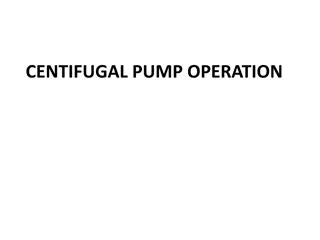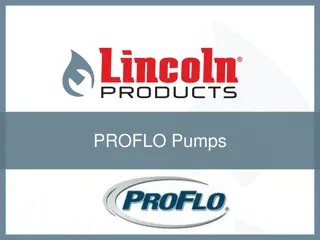Overview of API 682 Shaft Sealing System for Centrifugal Pumps
The presentation discusses the API 682 Shaft Sealing System for Centrifugal and Rotary Pumps, focusing on the Fall 2018 Sub-Committee meeting. It covers the task force membership, meeting summaries, and the status of API 682, highlighting the initiative's activation in Fall 2016 to address concerns from the pipeline industry and seal OEMs regarding current standards. The task force aims to expand coverage to applications typical for pipelines.
Download Presentation

Please find below an Image/Link to download the presentation.
The content on the website is provided AS IS for your information and personal use only. It may not be sold, licensed, or shared on other websites without obtaining consent from the author.If you encounter any issues during the download, it is possible that the publisher has removed the file from their server.
You are allowed to download the files provided on this website for personal or commercial use, subject to the condition that they are used lawfully. All files are the property of their respective owners.
The content on the website is provided AS IS for your information and personal use only. It may not be sold, licensed, or shared on other websites without obtaining consent from the author.
E N D
Presentation Transcript
API 682 Shaft Sealing System for Centrifugal & Rotary Pumps 2018 Fall Presentation for the Sub-Committee of Mechanical Equipment Chair: Jarrod Streets BP Vice Chair: Chris Andrews TechnipFMC Secretary: Morg Bruck - HMIC
Agenda for Fall 2018 SOME Meeting Introductions Task Force Membership Summary Status of API 682 Items for SOME Discussion Review Seal Category Spreadsheet Review Comment Resolutions Additional Questions or Comments from SOME
Task Force Membership Summary Member Type Member Count Member Count by % End Users 18 43 % EPC 6 14 % OEM 18 43% Total 42 100 % Fairly balanced membership between the three member types. Seeking more participation from pipeline End Users.
Task Force Meetings Summary Currently hold 90 minute teleconferences meetings every other Thursday. Plan to continue at this frequency until the first draft of 5 edition is complete. On average, about 50% of the task force attends the teleconferences. Participation in the teleconferences is fairly balanced by member type.
Status of API 682 The task force was activated in the Fall 2016 Primary reason for activation was to address concerns from the pipeline industry and seal OEMS that the current standard does not adequately cover pipeline pump applications. A presentation given to SOME in 2016 first highlighted this concern from the pipeline industry.
Status of API 682 In current form, this standard is not industry specific. The task force does not plan to change this format. There will be no specific Pipeline Annex or direct mention of Pipeline Seals. The document is application specific and the task force plans to expand to cover applications that are typical for pipelines. Currently identified shaft diameter and dynamic sealing pressure as areas within the standard that force seals to be labeled engineered seals .
Status of API 682 Polling of pipeline users and seal OEMs within the task force indicates 50-75% of pipeline seals have dynamic sealing pressures above 40 bar (600 psig) and Shaft diameter above 4.3 (110mm). Subcommittee plans to add a category 4 seal type to better cover pipeline seal applications
Status of API 682 PROPOSED CATEGORY 4 DESIGN CONDITIONS Seal Dynamic Sealing Press. Up to 100 bar (1450 psig) Shaft Diameter Up to 6 (150 mm) Operating Temperature -40 350 F (-40 - 176 C) Category CATEGORY 4
Status of API 682 The task force has concluded that the definition of engineered seals is inadequate because as written it removes engineered seals entirely from the scope of API 682.
Status of API 682 The definition of engineered seals will be clarified to cover seals within categories 1-4 that require custom engineered solutions. Seals not covered by categories 1-4 will be considered out-of-scope . Task force plans to review standard with the intent of simplifying the document and moving towards a more performance based document. Design criteria that pertains to all seal types will be in the main body of the document with category specific information covered in separate sections.
Status of API 682 Seal performance testing procedure to be updated for higher sealing pressures and diameters in category 4. Task force plans to coordinate with API 610 to establish seal chamber dimensions for increased dynamic sealing pressures and larger shaft diameters. Taskforce has addressed the majority of comments submitted on the 4thed.
Items for SOME Discussion 1. What is the expected coverage of applications within an API document? (90/10; 80/20?) 1st edition set out to cover 90% of refinery applications through polling existing pump applications. What if application has a significant impact on safety and or regulations?
Items for SOME Discussion 2. Currently discussing how much to increase the dynamic sealing pressure covered within API 682. Current design pressure limit 40 bar (600 psi) For pipeline applications, members are commonly seeing dynamic sealing pressures of 100 bar (1450 psi). Nominally the pressure rating for 600# flanges. Seeking more information from SOME on issues with high sealing pressure in pipeline applications.
Items for SOME Discussion 3. Clarifying definition of acceptable leakage rates. Recommend developing performance based testing requirements for all seals. Other than during testing, the task force does not plan to provide additional guidance on acceptable seal leakage during equipment operation beyond section 4.2C. For category 1-3.
Items for SOME Discussion 3. Clarifying definition of acceptable leakage rates. (Cont.)
Items for SOME Discussion 3. Clarifying definition of acceptable leakage rates. (Cont.) Leakage rate objectives for category 4 seals to be discussed further. It is felt that this is a End User decision based on many variables such as safety, environment, personnel, economic, etc. There are too many variable to consider that would cover all applications.
Items for SOME Discussion 4. The task force needs to coordinate with API 610 for seal chamber dimensions. Recent revision to definition of MAWP of pump casings has defaulted on having suction rated for discharge pressure. This may effect standard seal chamber dimensions.
Items for SOME Discussion 5. Hydrotesting of Accessories. Currently hydrotest requirements for seal gland and accessories is 1.5 x MAWP to match API 610. Recommendation to remove seal accessories (Piping, Seal Pots, Etc.) from this requirement and instead default to the applicable design standard for the accessory. i.e. ASME Sec VIII/B31.1.
Items for SOME Discussion 5. Should the task force address electronic data exchange (EDE) data sheets in the new edition? How are other standards dealing with this topic?
Items for SOME Discussion 6. Task force is questioning the applicability of API 682 to rotary pumps. Currently API 682 is not written to adequately meet the sealing requirements of most rotary pumps. Taskforce recommends rewording the scope with respect to rotary pumps.
Review Seal Category Table Review in Excel
Review Resolutions from 4thEdition Comments Review in Microsoft Word document























